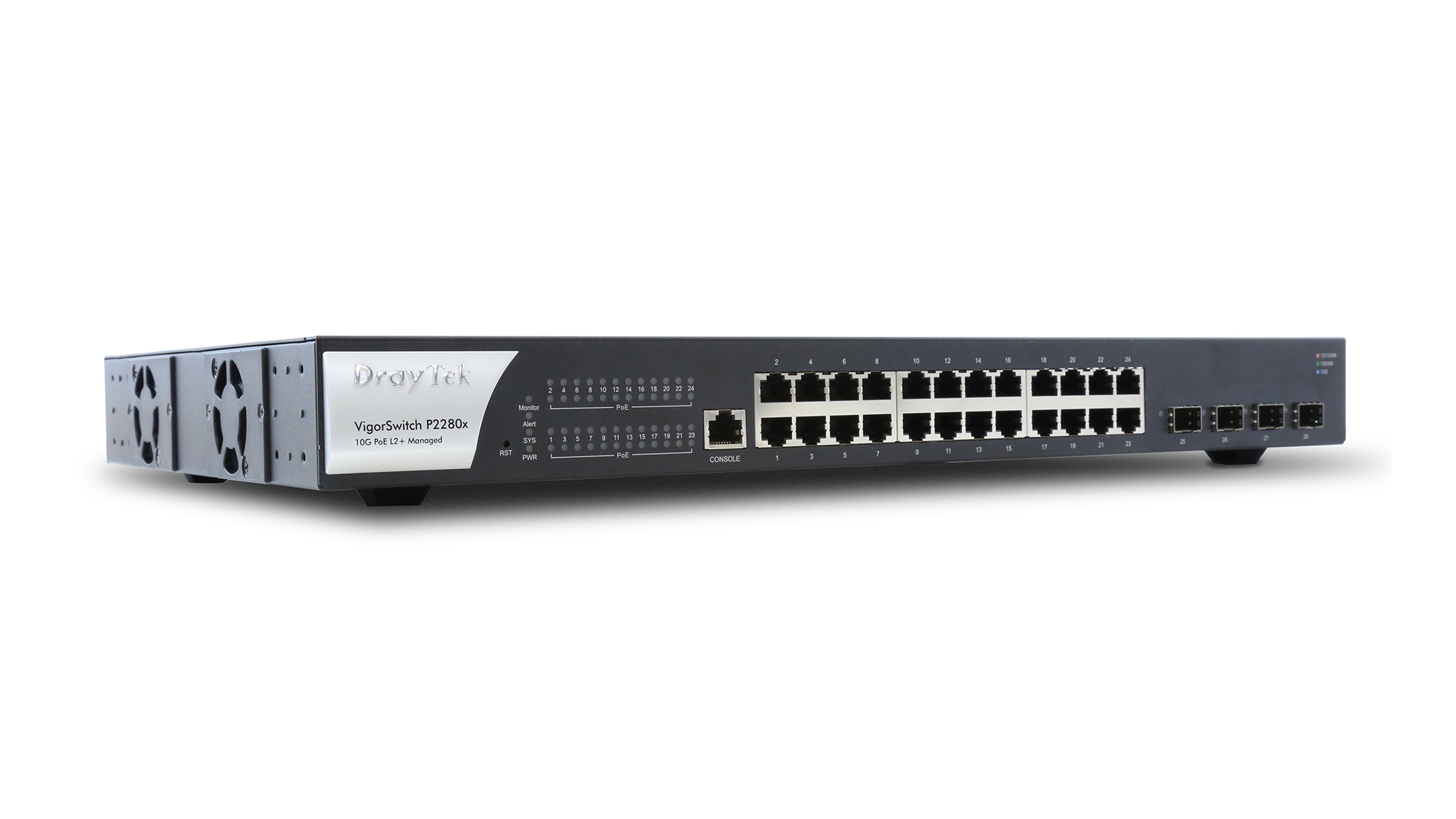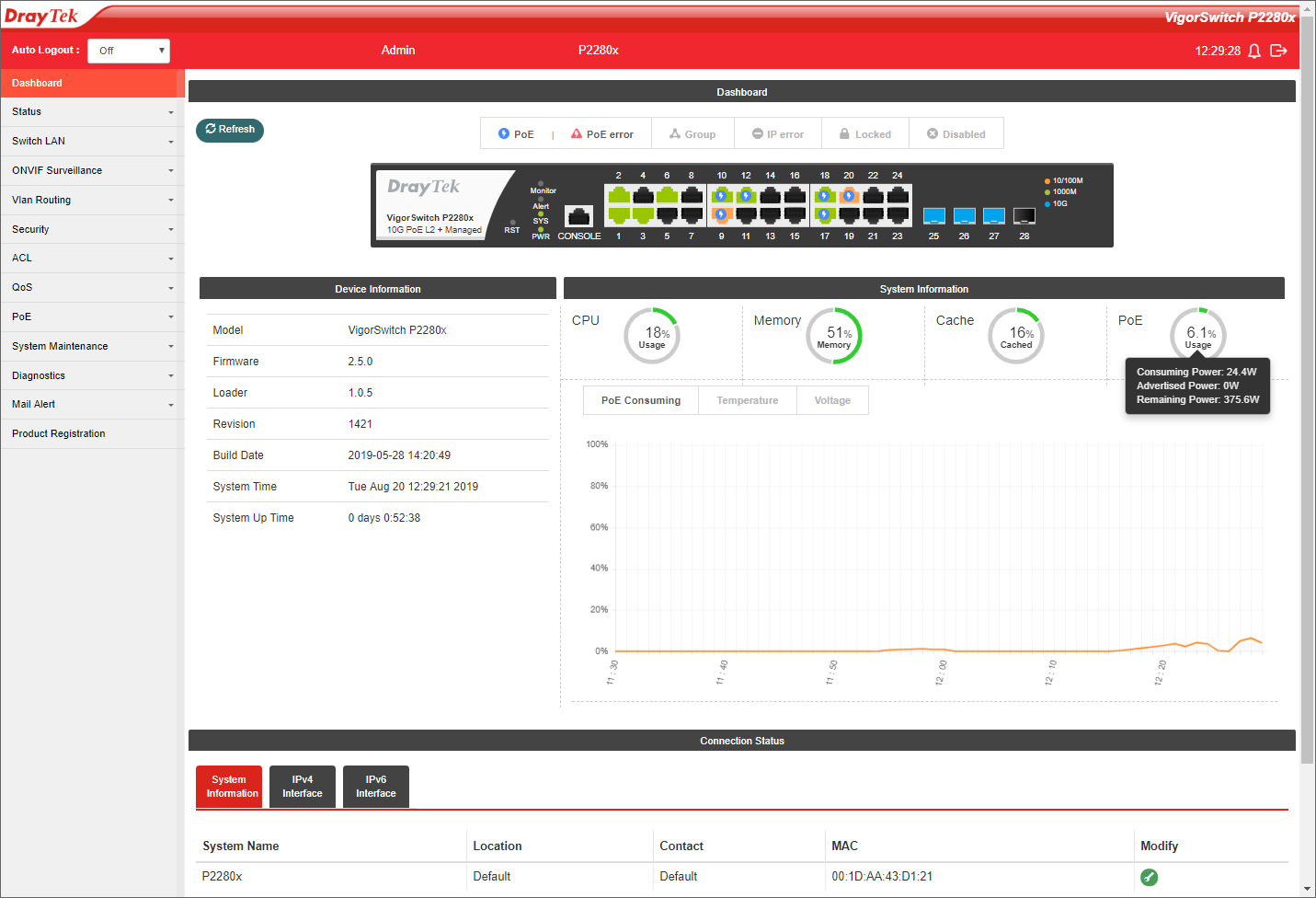DrayTek VigorSwitch P2280x review: Smart and switched on
This 10GbE-enabled switch has a wealth of features and a big PoE power budget at a remarkably low price


For businesses that want to upgrade to 10GbE, you won’t find a more feature-rich and powerful package at this price; DrayTek’s VigorSwitch P2280x is an absolute knockout
-
+
Excellent management features; Huge power budget; Basic L3 routing capabilities
-
-
None to speak of

If your business is ready to make the jump to high-performance 10-Gigabit Ethernet (10GbE), DrayTek's latest switches could be the perfect choice. The VigorSwitch P2280x and G2280x are the company's first 10GbE-enabled models, and they deliver an impressive range of features at a price so low it will have the competition scratching their heads.
The focus isn't just on speed, mind you, but also on power. Alongside their four 10GbE SFP+ fibre ports, both models offer two dozen regular Gigabit ports, and the P2280x supports Power-over-Ethernet (PoE) on all 24 of them. Its huge 400W total power budget is more than you'll get from many more expensive switches, making it a great choice for powering the latest PoE+ IP phones, IP cameras and high-performance wireless APs.
The 10GbE ports, meanwhile, can be used to connect high-bandwidth servers or NAS appliances; DrayTek's passive direct attach copper (DAC) cables cost a very reasonable 30 for the 3m version. A promised future firmware upgrade will let you use the 10GbE ports to join multiple switches together into a virtual stack and manage them from one IP address.
Even with the current firmware, management is a standout feature. The PB2280x can be managed from any DrayTek router that supports its Central Switch Management technology for centrally deployed PoE profiles and schedules; alternatively, you can use DrayTek's cloud-hosted VigorACS 2 service. Costing 8 per node per year, this provides cloud management and monitoring services for a range of distributed DrayTek routers, wireless APs and switches, including the P2280x.
If that's overkill for your business, the P2280x also offers a slick and very informative web console of its own. The dashboard presents a smart switch graphic, with colour-coded icons clearly showing each port's connection speed. When a PoE device is connected, the port icon gets a lightning bolt, with a pop-up window showing its current power draw. Below, a row of four ring graphs show CPU, memory, cache and PoE utilisation, while the line graph at the bottom can be switched between showing PoE usage, CPU and system temperatures or voltages.

From the console you can also set up power profiles, which control when power is supplied to selected ports. Using custom schedules based on up to 15 rules, you can decide precisely when each one should turn on and off so, for example, you can turn off your wireless network over the weekend for greater security.
To get a sense of the P2280x's PoE potential, we connected a PoE+ Class 4 802.11ac wireless AP from Linksys, two Class 0 802.11ac Ubiquiti NanoHD APs and a Ubiquiti Cloud Key Gen2 appliance along with a pair of Class 0 IP cameras. The web console reported a total draw of 24.4W; that meant we still had 375.6W in reserve, enough to add a lot more devices.
If you do manage to get close to the power budget, you can assign one of three priorities to each port to ensure critical devices stay on: if the drain reaches the power threshold, the ports with the lowest priority will be switched off first.
Networking features are well covered, too. Standard L2 features include port, MAC and protocol-based VLANs and QoS traffic prioritisation, plus static and LACP link aggregation groups. The switch will spot VoIP devices connecting to the network and automatically prioritise their traffic, and its clever ONVIF feature discovers compliant IP cameras and can pipe their RSTP live video stream straight into its web interface.
What's more, while the P2280x is a Layer 2 switch, it also has basic Layer 3 routing capabilities (an arrangement sometimes referred to as "Layer 3 Lite" or "Advanced L2+"). This means it supports static IPv4 and IPv6 routing and inter-VLAN local routing, although not the dynamic routing found in more costly full Layer 3 switches.
The VigorSwitch P2280x delivers a wealth of features, plenty of management choices and a big power budget at a low price. Small businesses that want a fast, powerful network won't find a more affordable alternative.
Verdict
For businesses that want to upgrade to 10GbE, you won’t find a more feature-rich and powerful package at this price; DrayTek’s VigorSwitch P2280x is an absolute knockout
1U rack chassis
24 x Gigabit Ethernet with PoE/PoE+
4 x 10GbE SFP+ ports
400W power budget
802.3af/at PoE
128Gbits/sec backplane capacity
12MB packet buffer
16K MAC addresses
Internal PSU
Web-based management portal
2yr RTB warranty
Get the ITPro daily newsletter
Sign up today and you will receive a free copy of our Future Focus 2025 report - the leading guidance on AI, cybersecurity and other IT challenges as per 700+ senior executives
Dave is an IT consultant and freelance journalist specialising in hands-on reviews of computer networking products covering all market sectors from small businesses to enterprises. Founder of Binary Testing Ltd – the UK’s premier independent network testing laboratory - Dave has over 45 years of experience in the IT industry.
Dave has produced many thousands of in-depth business networking product reviews from his lab which have been reproduced globally. Writing for ITPro and its sister title, PC Pro, he covers all areas of business IT infrastructure, including servers, storage, network security, data protection, cloud, infrastructure and services.
-
 Nvidia braces for a $5.5 billion hit as tariffs reach the semiconductor industry
Nvidia braces for a $5.5 billion hit as tariffs reach the semiconductor industryNews The chipmaker says its H20 chips need a special license as its share price plummets
By Bobby Hellard Published
-
 Business leaders are having a crisis of confidence over data literacy
Business leaders are having a crisis of confidence over data literacyNews A Salesforce survey reveals business leaders don't trust their data, or their ability to make the most of it
By Emma Woollacott Published
-
 MITRE CVE program handed last minute reprieve amid funding lapse concerns
MITRE CVE program handed last minute reprieve amid funding lapse concernsNews The MITRE Corporation's Common Vulnerabilities and Exposures (CVEs) database has been handed a last minute reprieve amid concerns over funding.
By Rory Bathgate Last updated